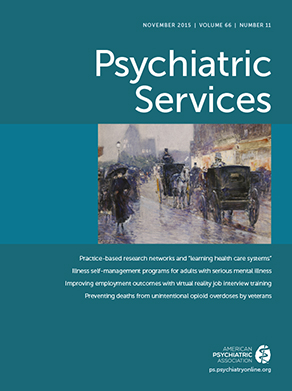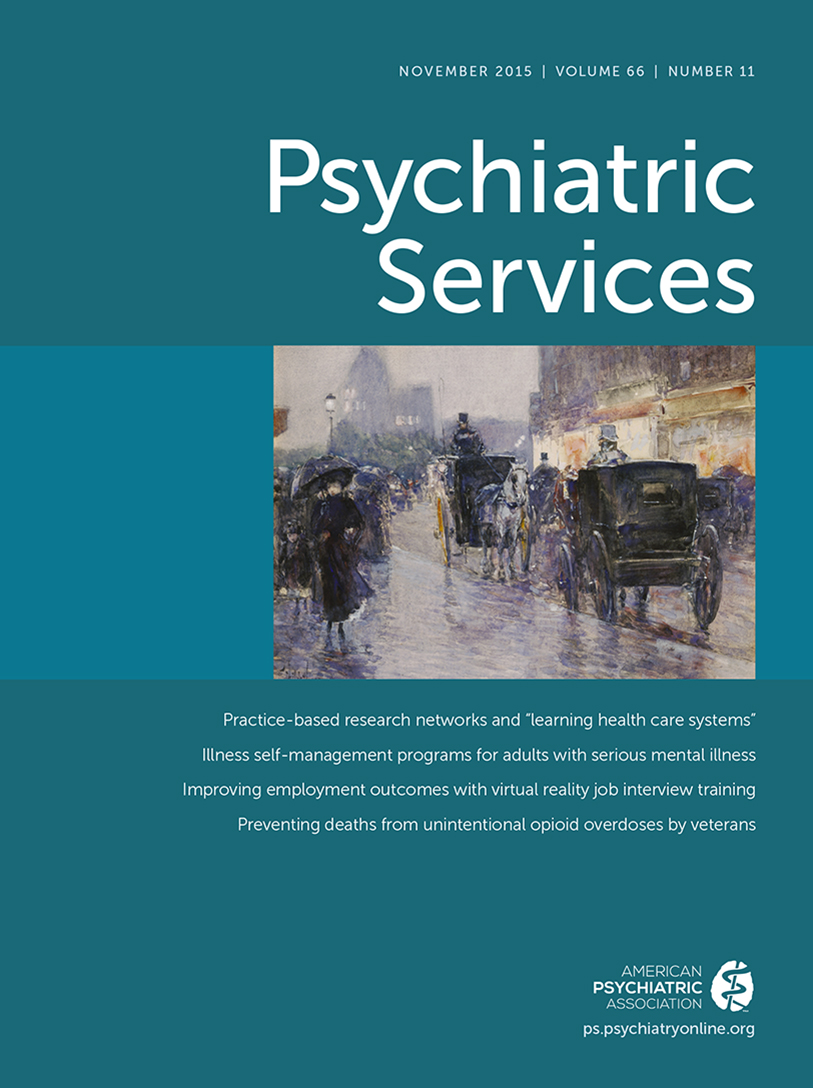Meeting the mental health needs of older adults in the United States will be particularly challenging as the aging population places growing demands on the resources of the health care system. Treatment for mental illness among older adults poses unique challenges requiring careful consideration. Pharmacotherapy is often different for older adults because of age-associated changes in pharmacokinetics and pharmacodynamics and high rates of multiple general medical comorbid conditions, which increase risk of polypharmacy, drug interactions, and adverse drug events (
1,
2). Evidence-based psychotherapies are generally as effective with older adults as with younger adults but require specific adaptations to pace and process (
3). Older adults use mental health services at very low rates (
4,
5) because of a variety of barriers at individual, system, and policy levels (
6). Older patients are more likely to receive mental health treatment in primary care settings (
7). However, primary care providers often fail to detect mental illness among older patients and spend little time on mental well-being during visits (
8). Managing the complex needs of older adults with mental illness often requires coordination across health care providers as well as settings.
The U.S. veteran population is older than the overall U.S. population (
9). For several reasons, older veterans may be at higher risk of mental illness compared with their nonveteran counterparts. Many older veterans experienced combat and may suffer the long-term effects of such exposure, including posttraumatic stress disorder (
10). Veterans also make up a disproportionate share of populations that may be at increased risk for stress-related disorders, including police officers, emergency personnel, and homeless individuals. It is anticipated that substance use disorders will be a growing concern as the cohort of Vietnam veterans ages, given the group’s higher lifetime prevalence of alcohol and drug use disorders (
11).
Limited research to date has examined rates of mental illness and patterns of health care utilization among older veterans. We used national data from Veterans Health Administration (VHA) electronic medical records to examine rates of mental illness and health care service use among older veterans since 2005, when VHA implemented significant enhancements to mental health care as part of its transformation efforts (
12). To this end, VHA has promoted integrated, interdisciplinary models of mental health care delivery in various settings that serve older veterans, including primary care, home-based primary care, nursing home, and palliative care settings. In light of these developments and their national breadth, VHA provides a unique opportunity to examine trends of mental health need and service use among older adults.
Methods
We extracted data from VHA electronic medical record for each fiscal year from 2005 through 2013, including outpatient clinical encounters, inpatient admissions (including community living centers, which are facilities similar to nursing homes), and residential treatment admissions. Veterans who received only pharmacy services from VHA and those who received only fee-based contract care (medical care provided outside of U.S. Department of Veterans Affairs [VA] facilities but paid for by VA) were not included.
We identified unique veterans who received any in-person VHA health services for each fiscal year. Age was determined by date of birth and subsequent age on October 1 of each year (the start of the fiscal year). The sample included veterans age 65 and older. We did not de-duplicate records across years, so that if a veteran was seen in multiple years that individual was included in all of those years. Among those receiving any health care services, we next identified the number and proportion whose clinical encounters were coded with ICD-9 psychiatric diagnoses, which included most psychiatric disorders and substance use disorders. [An appendix in the online supplement to this report provides details.] Notably excluded were ICD-9 codes for Alzheimer’s disease and other dementias (because it is standard within VHA to consider uncomplicated dementia to be a neurologic condition), nicotine dependence (due to high rates of smoking in the veteran population), and developmental disorders.
We considered veterans to have a “confirmed mental illness” if they had at least two outpatient clinical encounters or one inpatient or residential bed day with a mental disorder recorded as one reason for the visit or admission, consistent with past convention (
13). We required two visits for outpatient diagnoses in order to filter out veterans who may have been assessed for a disorder but not ultimately diagnosed as having it. We used discharge, rather than admission, diagnoses for inpatient and residential services, under the assumption that diagnoses would be confirmed by the time of discharge. The visits or admission did not need to be located in a specialty mental health clinic or psychiatric treatment program but could occur in any outpatient clinic or inpatient service.
Once we identified annual cohorts of older adults with a psychiatric disorder, we captured utilization data for each fiscal year. This included the proportion who received any specialty mental health care in VHA and the utilization of non–mental health care services. We then compared rates of utilization and changes over time.
The human subject subcommittee of the Veterans Affairs Connecticut Healthcare System approved the study with waivers of HIPAA and informed consent.
Results
In 2013, 2.6 million older adults used services in VHA, 363,467 (14%) of whom had a confirmed mental illness. The proportion of the older veteran population with confirmed mental illness in 2013 increased 57% from 2005. Among the older veterans with mental illness, 273,000 (75%) received mental health treatment, compared with 131,134 (64%) in 2005. This increase was driven largely by increases in utilization of outpatient mental health services.
The proportion of non–mental health services provided to veterans with confirmed mental illness grew during the study period (
Table 1). Even though older adults with confirmed mental illness accounted for only 14% of the older adult population in 2013, they accounted for 39% of non–mental health inpatient hospitalizations, 28% of non–mental health outpatient encounters, and 49% of nursing home stays.
The average age of the sample decreased from 2005 to 2012 (from 75.8 to 75.5 years, respectively), with the cohort of older adults with confirmed mental illness also showing a decrease (from 75.6 to 72.1 years).
Discussion
Increased rates of confirmed mental illness between 2005 and 2013 suggest efforts related to screening and to integration of mental health services into primary care and other settings have increased mental illness detection and service use among older veterans. This is noteworthy, given the history of significant underdiagnosis and underutilization of mental health services in this population (
8).
It is important to note that the current utilization findings, based on a health care treatment-seeking population, contrast with findings of recent population-based studies. For example, Byers and colleagues (
4) found that less than one-third of older adults with mood and anxiety disorders used mental health services, compared with our rate of 75%.
Our data showing higher rates of non–mental health service utilization by older veterans with mental illness in the face of decreasing average age of the cohort suggests that greater access to services, not relative aging of the cohort, has led to the increased utilization. This finding also emphasizes the growing necessity for educating non–mental health providers about the needs of the growing geriatric mental health population. The Institute of Medicine’s 2012 report
The Mental Health and Substance Abuse Workforce for Older Adults: In Whose Hands? documents that the rate of specialized providers entering the workforce is dwarfed by the booming population of older adults (
14). In addition to building a workforce that includes specialty-trained geriatric psychiatrists, psychologists, nurses, and social workers, our health care system must provide basic geriatric mental health education not only to clinicians working in general medical and surgical settings but also to caregivers and community health workers. Enhancing this much-needed geriatric workforce has been a focus within VHA (
15).
Conclusions
Increasing the attention paid to the mental health needs of older veterans and nonveterans is essential to their care. The findings reported here suggest that system efforts to increase both the detection of mental health problems (such as through systematic screening) and service access for older adults may increase utilization and reduce enduring unmet need. With an increasing number of older adults with mental illness seeking care in varied settings, the workforce must be fully prepared to address the often complex needs of this patient population.

